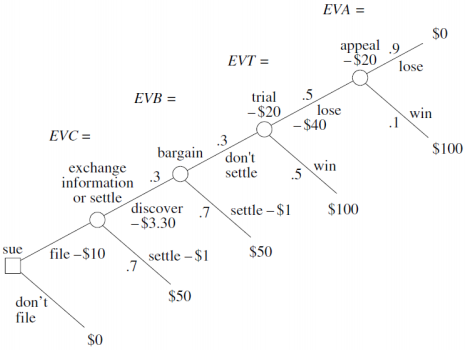Reference no: EM131303642
Law and Economics Problem Set
Question 1: Legal Value of a Claim
The tree below is identical to the tree we saw in class.

Questions:
a) Alter the figure so that a trial (but not the appeal) costs the plaintiff $40 instead of $20, and settlement is for $51 instead of $50. Solve recursively for the expected values of the legal claim by filing in the blanks at each stage. What is the plaintiff's expected net profit from filing a complaint.
b) In Europe, the party who loses at trial pays the litigation costs of the winner. Assume that the plaintiff in the preceding figure pays litigation costs of $40 if she loses at trial, and the plaintiff pays litigation costs of $0 if she wins. Re-compute the expected values of the legal claim under this assumption.
c) Change the figure above so that the plaintiff wins $40 (not $100) at trial with probability .5 (again, as in part a, assume that each party pays his or her own legal fees). A nuisance suit is one in which the expected value of trial is non-positive (EVT ≤ 0). Is this a nuisance suit?
Question 2: Pre-Trial Bargaining
An accident has occurred, causing $10,000 in harm to the victim. The amount of harm done is undisputed and easy to prove; punitive damages are not applicable, so any damage award would be for exactly $10,000.
This type of accident is governed by strict liability, so the injurer is legally responsible, but it may be difficult to prove in court that he caused the harm. The victim can hire a lawyer for $3,000 and go to trial, in which case he would have a 40% chance of winning. He could also hire an expert witness to testify. This would ensure victory at trial, but would cost an additional $10,000, for a total of $13,000. Going to trial costs the defendant (injurer) $5,000, regardless of whether the plaintiff (victim) hires an expert witness. Assume that neither party pays any legal expenses if an out-of-court settlement is reached.
Questions:
First, consider the usual American rule where each party pays its own legal fees.
a) If the case goes to trial, will the plaintiff hire an expert witness or not?
b) Calculate each party's threat value during pre-trial negotiations (again, this is the amount each party would get if they did not cooperate and instead went to trial).
c) Calculate the cooperative surplus.
d) Determine the settlement that would occur if the two parties agreed to divide the gains from cooperative evenly. In other words, what is a "reasonable solution?"
e) In this scenario, would the American rule lead to over-, under-, or efficient precaution on the part of the injurer?
Next, consider the usual British rule where the losing party pays both sides' legal fees (including the cost of the expert witness, if he was hired).
f) If the case goes to trial, will the plaintiff hire an expert witness?
g) Calculate each party's threat value during pre-trial negotiations
h) Calculate the cooperative surplus
i) Determine the settlement that would occur if gains from cooperation were divided evenly.
j) In this scenario, would the British rule lead to over-, under-, or efficient precaution on the part of the injurer?
Question 3: A Civil Dispute
Arthur alleges that Betty borrowed a valuable kettle and broke it, so he sues to recover its value, which is $300. The facts are very confusing. Betty contends that she did not borrow a kettle from Arthur; even if it is proved that she borrowed a kettle from Arthur, she contends it is not broken; even if it is proved that she borrowed a kettle from Arthur and that it is broken, she contends that she did not break it.
Assume that because the facts in the case are so unclear, Arthur and Betty independently believe that the chances of either side's winning in court are an even 50%. Further assume that litigation in small claims court will cost each party $50 and that the costs of settling out of court are nil. So, cooperation in this case is a matter of settling out of court and saving the cost of a trial. Non-cooperation in this case means trying the dispute.
Questions:
a) What is Arthur's threat value? (Again, this is the amount Arthur would get if he did not cooperate and instead went to trial).
b) What is Betty's threat value? (Again, this is the amount Betty would get if she did not cooperate and instead went to trial).
c) What is the non-cooperative value of the game (i.e., the sum of their threat values)?
d) What is the cooperative value of the game?
e) What is the cooperative surplus?
f) What would be a reasonable settlement? How much would Betty offer to pay Arthur?
Suppose that instead of both sides' believing that there is an even chance of winning, both sides are optimistic. Specifically, Arthur thinks that he will win with probability 2/3, and Betty thinks that she will win with probability 2/3.
g) What is Arthur's subjective threat value (what he believes he will get if they went to)?
h) What is Betty's subjective threat value (what she believes she will get if they went to trial)?
i) What is the putative cooperative surplus (Cooperative Value-Non-cooperative Value)?
j) Will the parties be able to reach a settlement?